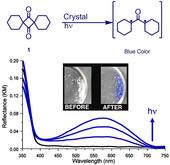Highlight
Generation, Trapping and Characterization of Highly Reactive Intermediates in the Crystalline State
Achievement/Results
With support by the National Science Foundation, a team of researchers at the University of California-Los Angeles, in collaboration with researchers at the Universität Erlangen-Nürnberg, have successfully isolated oxyallyl, one of the last organic reaction intermediates to be isolated and characterized. Oxyallyl is chemical species with three carbons and one oxygen that is sometimes viewed as an ionic species, and others as a neutral, and potentially magnetic biradical. Oxyallyl has been postulated many times before but it has never been detected. The knowledge acquired in this study will lead to the rational design and discovery of new chemical reactions and will help devise strategies to generate and stabilize unstable molecules with desirable materials properties.
The international research team generated and characterized the reactive intermediate oxyallyl embedded in the crystal lattice of cyclobutanedienone 1 (Figure 1) and confirmed its spectroscopic signatures with state of the art quantum chemical calculations and ultrafast spectroscopic methods in solution. The team has shown that the lowest energy state of oxyallyl is a singlet state biradical species, helping settle down early speculations that suggested a paramagnetic triplet state species.
The discovery and clarification of the electronic state of oxyallyl is important because it is one of the most ubiquitous reaction intermediates, involved in many organic reactions, including the Nazarov cyclization and Favoroskii rearrangement among many others. While many synthetic applications rely on the formation of oxyallyl during the reaction, all previous attempts at direct detection, isolation, and characterization have failed. This is in contrast to most other reactive intermediates such as carbocations, carbanions, carbenes, and radicals, which have been previously isolated and characterized.
The international research team, lead by M. Garcia-Garibay at UCLA, has trapped this unusual molecule via a photochemical reaction of compound 1, which releases a molecule of CO when irradiated with UV-light in the solid state. The reaction proceeds both in solution and the solid state. When the photoreaction of 1 occurs in solution, oxyallyl undergoes a rapid ring closure within 10 picoseconds to form a three-membered ring structure. However, when the photoreaction was performed in crystals of 1 oxyallyl has a lifetime of tens of minutes. The reactive intermediate has a distinct blue color that and can be easily detected with the naked eye. The reason for oxyallyl to have such a long lifetime in the crystals is because it cannot undergo the motions required to form the product, and it becomes kinetically trapped. With a long lifetime in the crystals, the research team was able to fully characterize its spectroscopic properties by electronic and vibrational spectroscopies. Electron paramagnetic resonance was used to determine the diamagnetic properties of the biradical and ultrafast spectroscopic studies in solvents with different polarities were used to rule out a potential zwitterionic structure.
The newly confirmed electronic structure will allows the scientific community as a whole to rationally create new reaction methodologies that involves oxyallyl as a reactive intermediate. The use of reactions involving oxyallyl in the development of new drugs or materials has been limited in scope because of the ambiguity of the reactive species involved.
This work was possible through the funding and opportunities provided by the Materials Creation Training Program (MCTP) IGERT at UCLA. The work required an interdisciplinary and international team comprised of multiple research groups at UCLA, Prof. Miguel A. Garcia-Garibay and Prof. Kendall N. Houk, as well as the research team of Prof. Dr. Dirk M. Guldi at the Universität Erlangen-Nürnberg.
Each of these three research groups brought different talents and skills, which solved this problem that has befuddled many single discipline research groups in the past. It required the solid-state photochemical knowledge of Dr. Garcia-Garibay, the computational abilities of Dr. Houk, and the expertise of Prof. Dr. Guldi at ultrafast femtosecond spectroscopy. The MCTP IGERT grant allowed UCLA graduate student Gregory Kuzmanich, to travel to Erlangen to work on solving this problem creatively in the group of Dr. Guldi. Without the assistance of the three-month internship provided by the NSF, this work would not have succeeded.
Reference:
Kuzmanich, G., Spänig, F.; Tsai, C.K., Um, J.M., Hoekstra, R.M., Houk, K.N., Guldi, D.M., Garcia-Garibay, M.A. Oxyallyl Exposed: An Open Shell Singlet with Picosecond Lifetimes in Solution but Persistent in Crystals of a Cyclobutanedione Precursor. J. Am. Chem. Soc. 2010, 132, manuscript under revision.
Address Goals
The newly confirmed electronic structure will allows the scientific community as a whole to rationally create new reaction methodologies that involves oxyallyl as a reactive intermediate. The method illustrated in this work can be implemented to study other reactive species.






